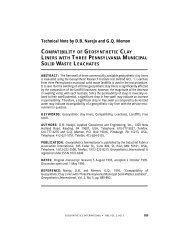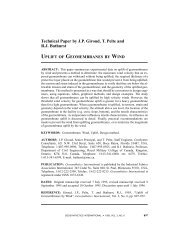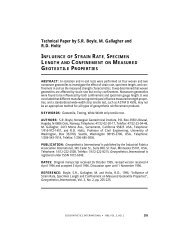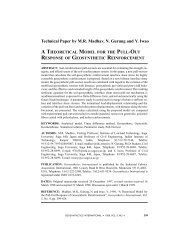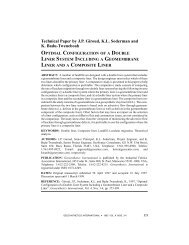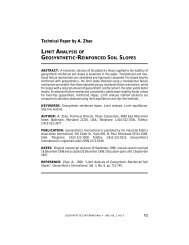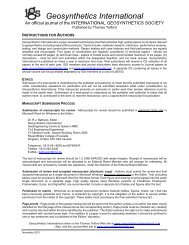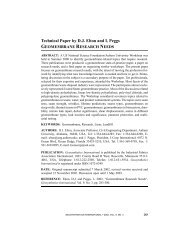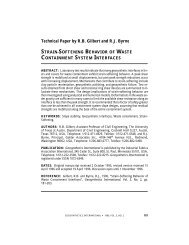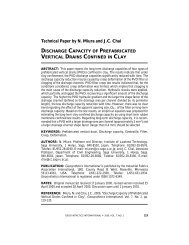leachate flow in leakage collection layers due to defects in ...
leachate flow in leakage collection layers due to defects in ...
leachate flow in leakage collection layers due to defects in ...
You also want an ePaper? Increase the reach of your titles
YUMPU automatically turns print PDFs into web optimized ePapers that Google loves.
GIROUD et al. D Leachate Flow <strong>in</strong> Leakage Collection Layers Due <strong>to</strong> Geomembrane Defects<br />
Y<br />
= y<br />
(25)<br />
Comb<strong>in</strong><strong>in</strong>g Equations 23, 24 and 25 gives the equation of the parabola <strong>in</strong> axes Ox and<br />
Oy as follows:<br />
y<br />
2<br />
2<strong>to</strong><br />
x <strong>to</strong><br />
= +<br />
2<br />
s<strong>in</strong>b<br />
s<strong>in</strong> b<br />
2<br />
(26)<br />
Equation 26 can also be written:<br />
y<br />
2<br />
2<br />
F<br />
HG<br />
<strong>to</strong><br />
x<br />
= 1+<br />
2<br />
2<br />
s<strong>in</strong> b<br />
s<strong>in</strong> b<br />
t<br />
o<br />
I<br />
KJ<br />
(27)<br />
4.1.2 Comment on the Development of the Equations<br />
It should be noted that the equation of the parabola was obta<strong>in</strong>ed with a m<strong>in</strong>imum<br />
amount of calculations because it was recognized <strong>in</strong> Section 2.2, us<strong>in</strong>g geometric considerations,<br />
that the curve had <strong>to</strong> be a parabola. Thus, it was straightforward <strong>to</strong> establish<br />
the equation of a parabola pass<strong>in</strong>g by three known po<strong>in</strong>ts, P, Pi and V (Figure 6). If it<br />
had not been recognized that the curve was a parabola, it would have been necessary<br />
<strong>to</strong> use the analytical method <strong>to</strong> determ<strong>in</strong>e the equation of an unknown curve, which consists,<br />
<strong>in</strong> this particular case, of determ<strong>in</strong><strong>in</strong>g <strong>in</strong> polar coord<strong>in</strong>ates the <strong>in</strong>tersection of a<br />
cone and an <strong>in</strong>cl<strong>in</strong>ed plane, and convert<strong>in</strong>g the obta<strong>in</strong>ed equation <strong>in</strong><strong>to</strong> cartesian coord<strong>in</strong>ates.<br />
The senior author has checked that this lengthy method yields Equation 27.<br />
4.1.3 Equations for the Case Where the Leakage Collection Layer is not Full<br />
Comb<strong>in</strong><strong>in</strong>g Equations 10, 23 and 26 gives the follow<strong>in</strong>g equations for the parabola<br />
that delimitates the wetted zone <strong>in</strong> the case where the <strong>leakage</strong> <strong>collection</strong> layer is not full:<br />
2 Q 2 X<br />
Y =<br />
k s<strong>in</strong> b<br />
(28)<br />
hence:<br />
y<br />
y<br />
2<br />
2<br />
2x Q/<br />
k Q<br />
= +<br />
2<br />
s<strong>in</strong> b k s<strong>in</strong> b<br />
F<br />
HG<br />
Q x<br />
1 2 s<strong>in</strong>b<br />
= +<br />
2<br />
k s<strong>in</strong> b Q/<br />
k<br />
I<br />
KJ<br />
(29)<br />
(30)<br />
230 GEOSYNTHETICS INTERNATIONAL S 1997, VOL. 4, NOS. 3-4




